Contemporary Business Environment Report: Marks & Spencer Case Study
VerifiedAdded on 2023/01/12
|11
|3813
|97
Report
AI Summary
This report delves into the contemporary business environment, examining both internal and external factors that influence organizational operations. It begins with an introduction to the business environment and its key components, including the economic and non-economic factors. The report uses Marks and Spencer as a case study to illustrate the impact of these factors. The discussion covers the economic environment, including micro and macro economic factors such as competitors, demand, market size, economic systems, and policies. It further explores the non-economic environment, encompassing socio-cultural, natural, demographic, and technological factors. The report also analyzes these factors through a SWOT analysis, providing a strategic planning framework. The report concludes with a summary of the findings and provides references.
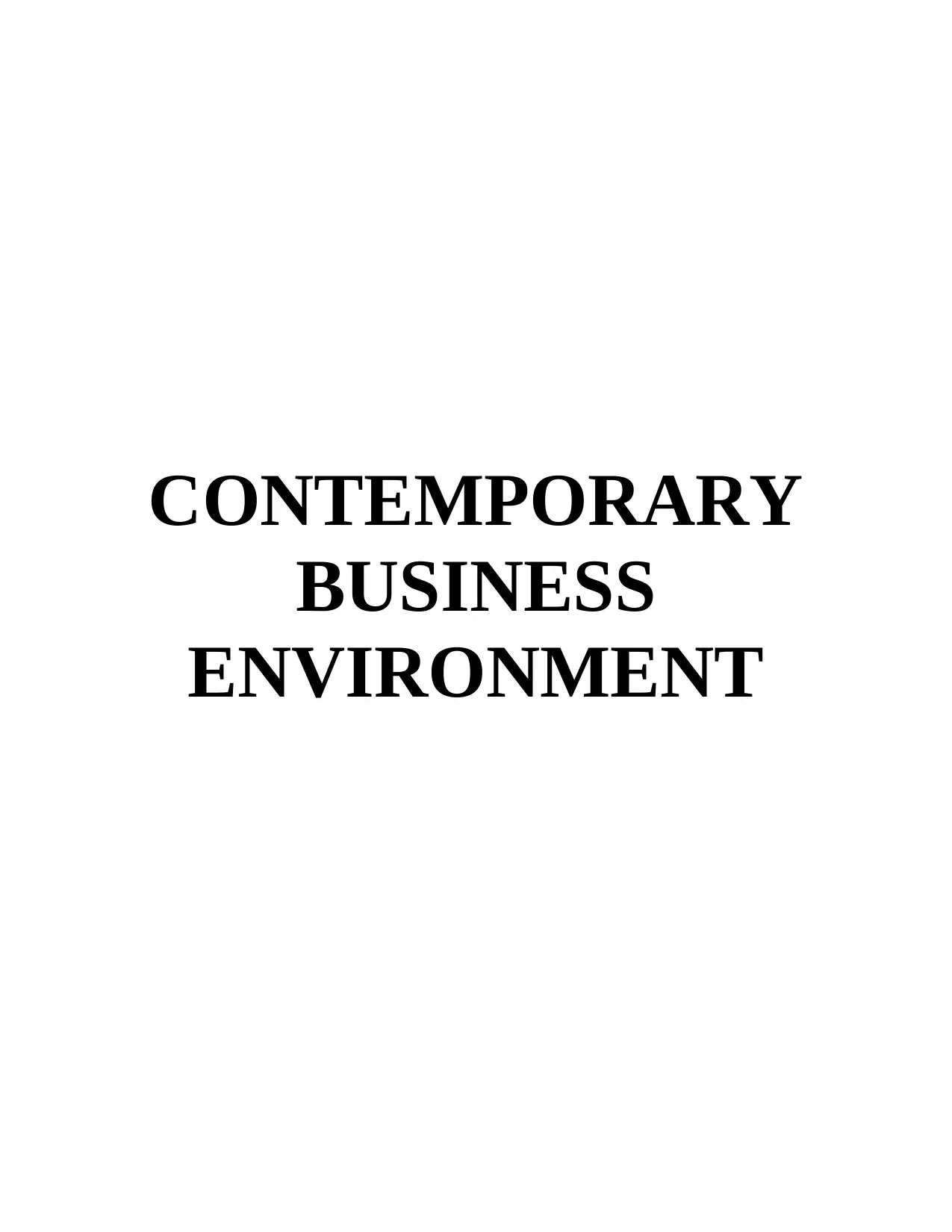
CONTEMPORARY
BUSINESS
ENVIRONMENT
BUSINESS
ENVIRONMENT
Paraphrase This Document
Need a fresh take? Get an instant paraphrase of this document with our AI Paraphraser
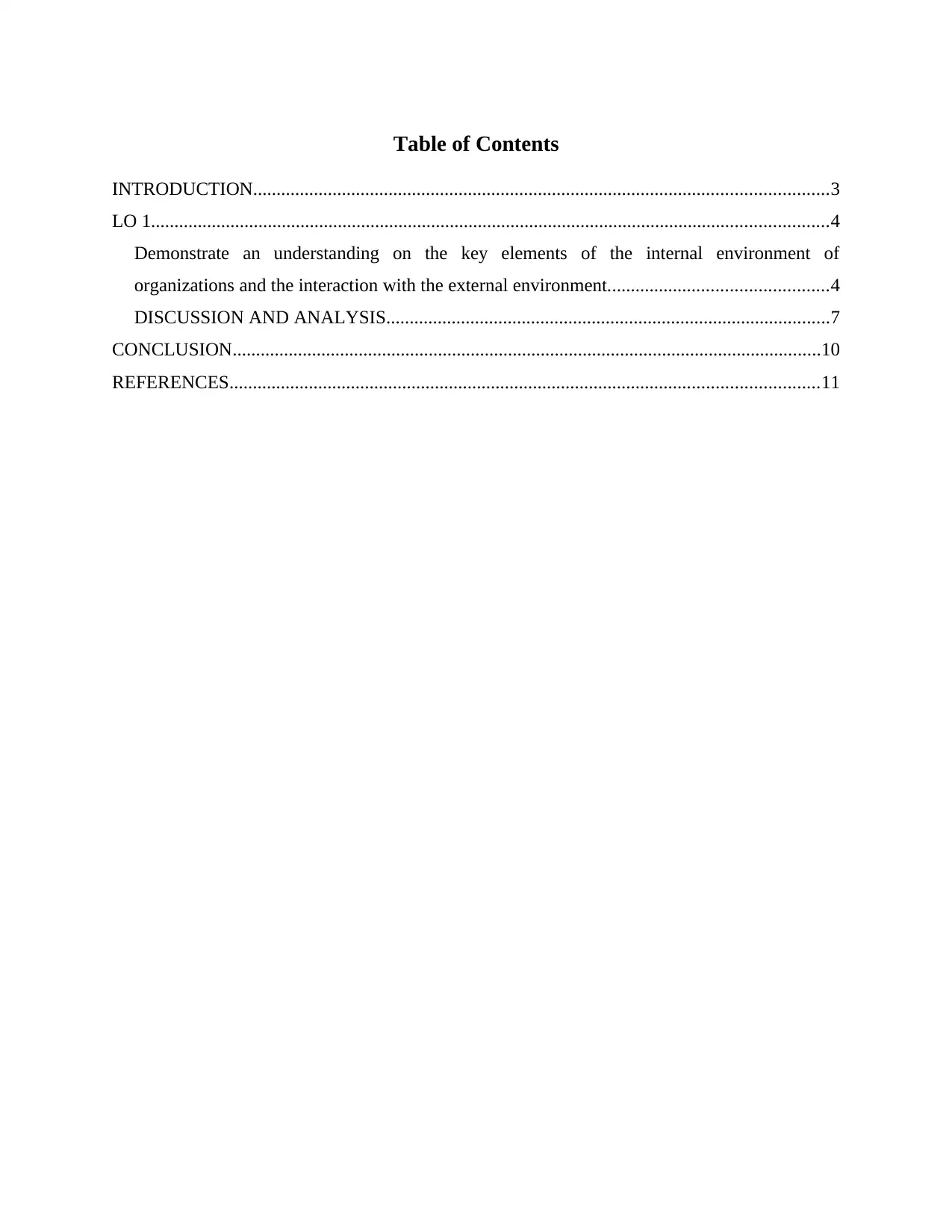
Table of Contents
INTRODUCTION...........................................................................................................................3
LO 1.................................................................................................................................................4
Demonstrate an understanding on the key elements of the internal environment of
organizations and the interaction with the external environment...............................................4
DISCUSSION AND ANALYSIS...............................................................................................7
CONCLUSION..............................................................................................................................10
REFERENCES..............................................................................................................................11
INTRODUCTION...........................................................................................................................3
LO 1.................................................................................................................................................4
Demonstrate an understanding on the key elements of the internal environment of
organizations and the interaction with the external environment...............................................4
DISCUSSION AND ANALYSIS...............................................................................................7
CONCLUSION..............................................................................................................................10
REFERENCES..............................................................................................................................11
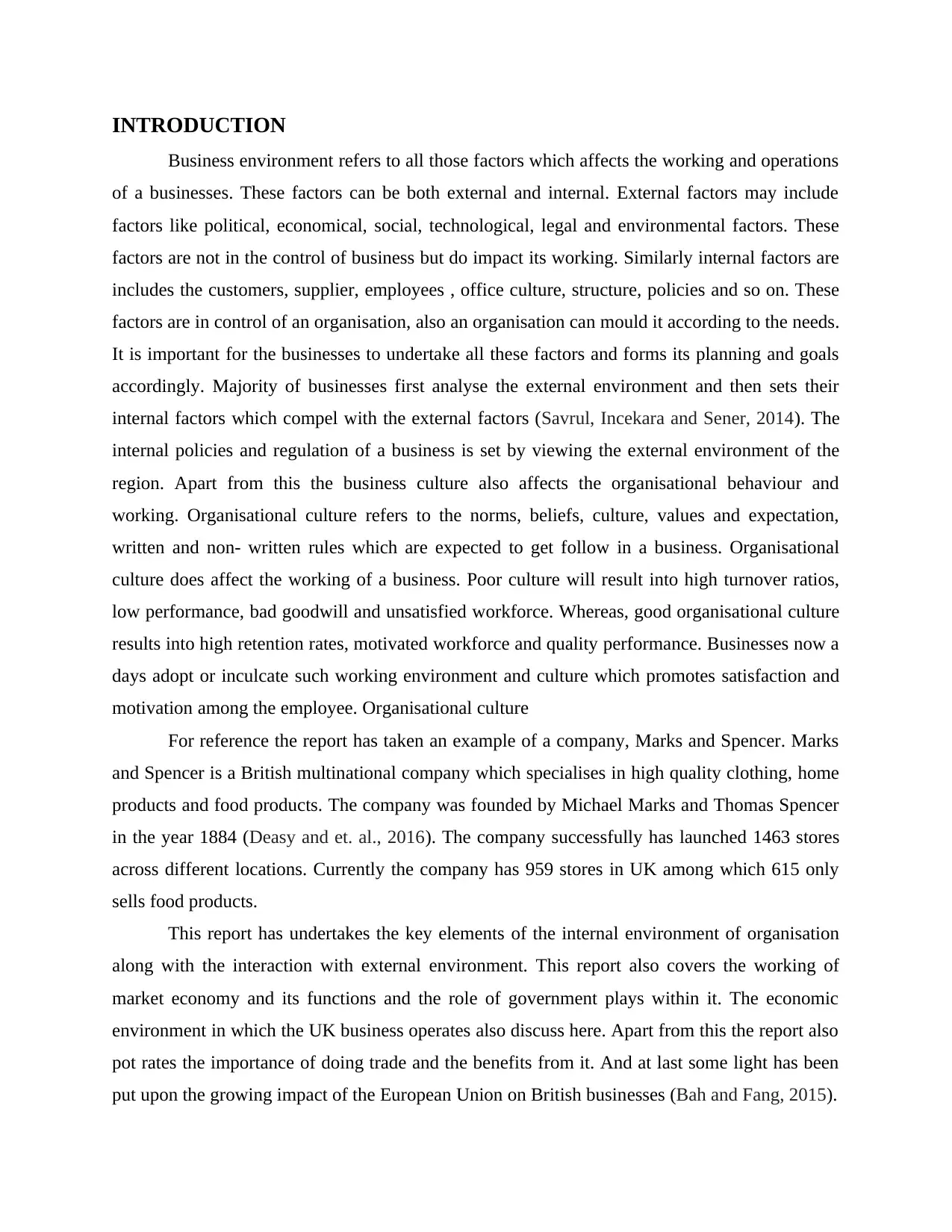
INTRODUCTION
Business environment refers to all those factors which affects the working and operations
of a businesses. These factors can be both external and internal. External factors may include
factors like political, economical, social, technological, legal and environmental factors. These
factors are not in the control of business but do impact its working. Similarly internal factors are
includes the customers, supplier, employees , office culture, structure, policies and so on. These
factors are in control of an organisation, also an organisation can mould it according to the needs.
It is important for the businesses to undertake all these factors and forms its planning and goals
accordingly. Majority of businesses first analyse the external environment and then sets their
internal factors which compel with the external factors (Savrul, Incekara and Sener, 2014). The
internal policies and regulation of a business is set by viewing the external environment of the
region. Apart from this the business culture also affects the organisational behaviour and
working. Organisational culture refers to the norms, beliefs, culture, values and expectation,
written and non- written rules which are expected to get follow in a business. Organisational
culture does affect the working of a business. Poor culture will result into high turnover ratios,
low performance, bad goodwill and unsatisfied workforce. Whereas, good organisational culture
results into high retention rates, motivated workforce and quality performance. Businesses now a
days adopt or inculcate such working environment and culture which promotes satisfaction and
motivation among the employee. Organisational culture
For reference the report has taken an example of a company, Marks and Spencer. Marks
and Spencer is a British multinational company which specialises in high quality clothing, home
products and food products. The company was founded by Michael Marks and Thomas Spencer
in the year 1884 (Deasy and et. al., 2016). The company successfully has launched 1463 stores
across different locations. Currently the company has 959 stores in UK among which 615 only
sells food products.
This report has undertakes the key elements of the internal environment of organisation
along with the interaction with external environment. This report also covers the working of
market economy and its functions and the role of government plays within it. The economic
environment in which the UK business operates also discuss here. Apart from this the report also
pot rates the importance of doing trade and the benefits from it. And at last some light has been
put upon the growing impact of the European Union on British businesses (Bah and Fang, 2015).
Business environment refers to all those factors which affects the working and operations
of a businesses. These factors can be both external and internal. External factors may include
factors like political, economical, social, technological, legal and environmental factors. These
factors are not in the control of business but do impact its working. Similarly internal factors are
includes the customers, supplier, employees , office culture, structure, policies and so on. These
factors are in control of an organisation, also an organisation can mould it according to the needs.
It is important for the businesses to undertake all these factors and forms its planning and goals
accordingly. Majority of businesses first analyse the external environment and then sets their
internal factors which compel with the external factors (Savrul, Incekara and Sener, 2014). The
internal policies and regulation of a business is set by viewing the external environment of the
region. Apart from this the business culture also affects the organisational behaviour and
working. Organisational culture refers to the norms, beliefs, culture, values and expectation,
written and non- written rules which are expected to get follow in a business. Organisational
culture does affect the working of a business. Poor culture will result into high turnover ratios,
low performance, bad goodwill and unsatisfied workforce. Whereas, good organisational culture
results into high retention rates, motivated workforce and quality performance. Businesses now a
days adopt or inculcate such working environment and culture which promotes satisfaction and
motivation among the employee. Organisational culture
For reference the report has taken an example of a company, Marks and Spencer. Marks
and Spencer is a British multinational company which specialises in high quality clothing, home
products and food products. The company was founded by Michael Marks and Thomas Spencer
in the year 1884 (Deasy and et. al., 2016). The company successfully has launched 1463 stores
across different locations. Currently the company has 959 stores in UK among which 615 only
sells food products.
This report has undertakes the key elements of the internal environment of organisation
along with the interaction with external environment. This report also covers the working of
market economy and its functions and the role of government plays within it. The economic
environment in which the UK business operates also discuss here. Apart from this the report also
pot rates the importance of doing trade and the benefits from it. And at last some light has been
put upon the growing impact of the European Union on British businesses (Bah and Fang, 2015).
⊘ This is a preview!⊘
Do you want full access?
Subscribe today to unlock all pages.

Trusted by 1+ million students worldwide
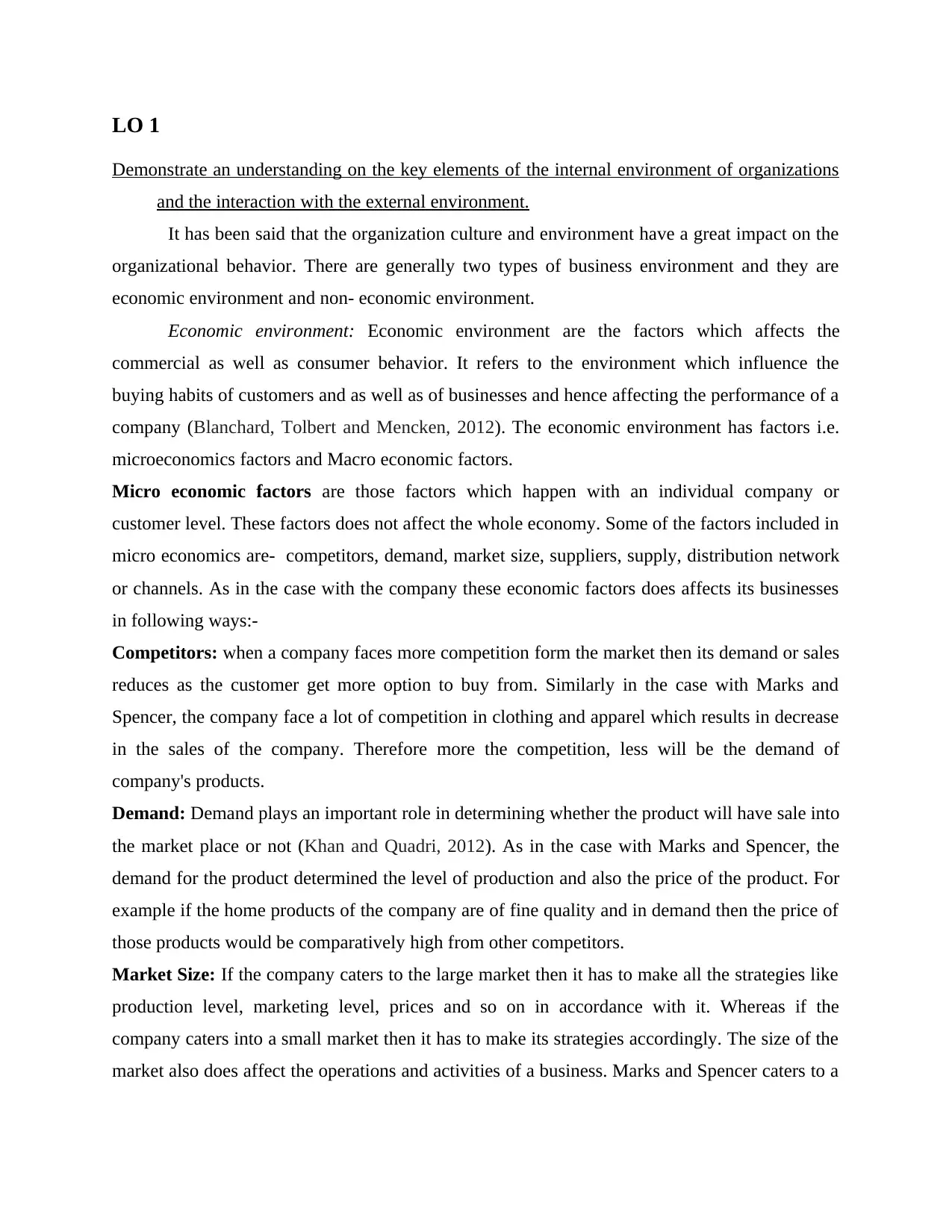
LO 1
Demonstrate an understanding on the key elements of the internal environment of organizations
and the interaction with the external environment.
It has been said that the organization culture and environment have a great impact on the
organizational behavior. There are generally two types of business environment and they are
economic environment and non- economic environment.
Economic environment: Economic environment are the factors which affects the
commercial as well as consumer behavior. It refers to the environment which influence the
buying habits of customers and as well as of businesses and hence affecting the performance of a
company (Blanchard, Tolbert and Mencken, 2012). The economic environment has factors i.e.
microeconomics factors and Macro economic factors.
Micro economic factors are those factors which happen with an individual company or
customer level. These factors does not affect the whole economy. Some of the factors included in
micro economics are- competitors, demand, market size, suppliers, supply, distribution network
or channels. As in the case with the company these economic factors does affects its businesses
in following ways:-
Competitors: when a company faces more competition form the market then its demand or sales
reduces as the customer get more option to buy from. Similarly in the case with Marks and
Spencer, the company face a lot of competition in clothing and apparel which results in decrease
in the sales of the company. Therefore more the competition, less will be the demand of
company's products.
Demand: Demand plays an important role in determining whether the product will have sale into
the market place or not (Khan and Quadri, 2012). As in the case with Marks and Spencer, the
demand for the product determined the level of production and also the price of the product. For
example if the home products of the company are of fine quality and in demand then the price of
those products would be comparatively high from other competitors.
Market Size: If the company caters to the large market then it has to make all the strategies like
production level, marketing level, prices and so on in accordance with it. Whereas if the
company caters into a small market then it has to make its strategies accordingly. The size of the
market also does affect the operations and activities of a business. Marks and Spencer caters to a
Demonstrate an understanding on the key elements of the internal environment of organizations
and the interaction with the external environment.
It has been said that the organization culture and environment have a great impact on the
organizational behavior. There are generally two types of business environment and they are
economic environment and non- economic environment.
Economic environment: Economic environment are the factors which affects the
commercial as well as consumer behavior. It refers to the environment which influence the
buying habits of customers and as well as of businesses and hence affecting the performance of a
company (Blanchard, Tolbert and Mencken, 2012). The economic environment has factors i.e.
microeconomics factors and Macro economic factors.
Micro economic factors are those factors which happen with an individual company or
customer level. These factors does not affect the whole economy. Some of the factors included in
micro economics are- competitors, demand, market size, suppliers, supply, distribution network
or channels. As in the case with the company these economic factors does affects its businesses
in following ways:-
Competitors: when a company faces more competition form the market then its demand or sales
reduces as the customer get more option to buy from. Similarly in the case with Marks and
Spencer, the company face a lot of competition in clothing and apparel which results in decrease
in the sales of the company. Therefore more the competition, less will be the demand of
company's products.
Demand: Demand plays an important role in determining whether the product will have sale into
the market place or not (Khan and Quadri, 2012). As in the case with Marks and Spencer, the
demand for the product determined the level of production and also the price of the product. For
example if the home products of the company are of fine quality and in demand then the price of
those products would be comparatively high from other competitors.
Market Size: If the company caters to the large market then it has to make all the strategies like
production level, marketing level, prices and so on in accordance with it. Whereas if the
company caters into a small market then it has to make its strategies accordingly. The size of the
market also does affect the operations and activities of a business. Marks and Spencer caters to a
Paraphrase This Document
Need a fresh take? Get an instant paraphrase of this document with our AI Paraphraser
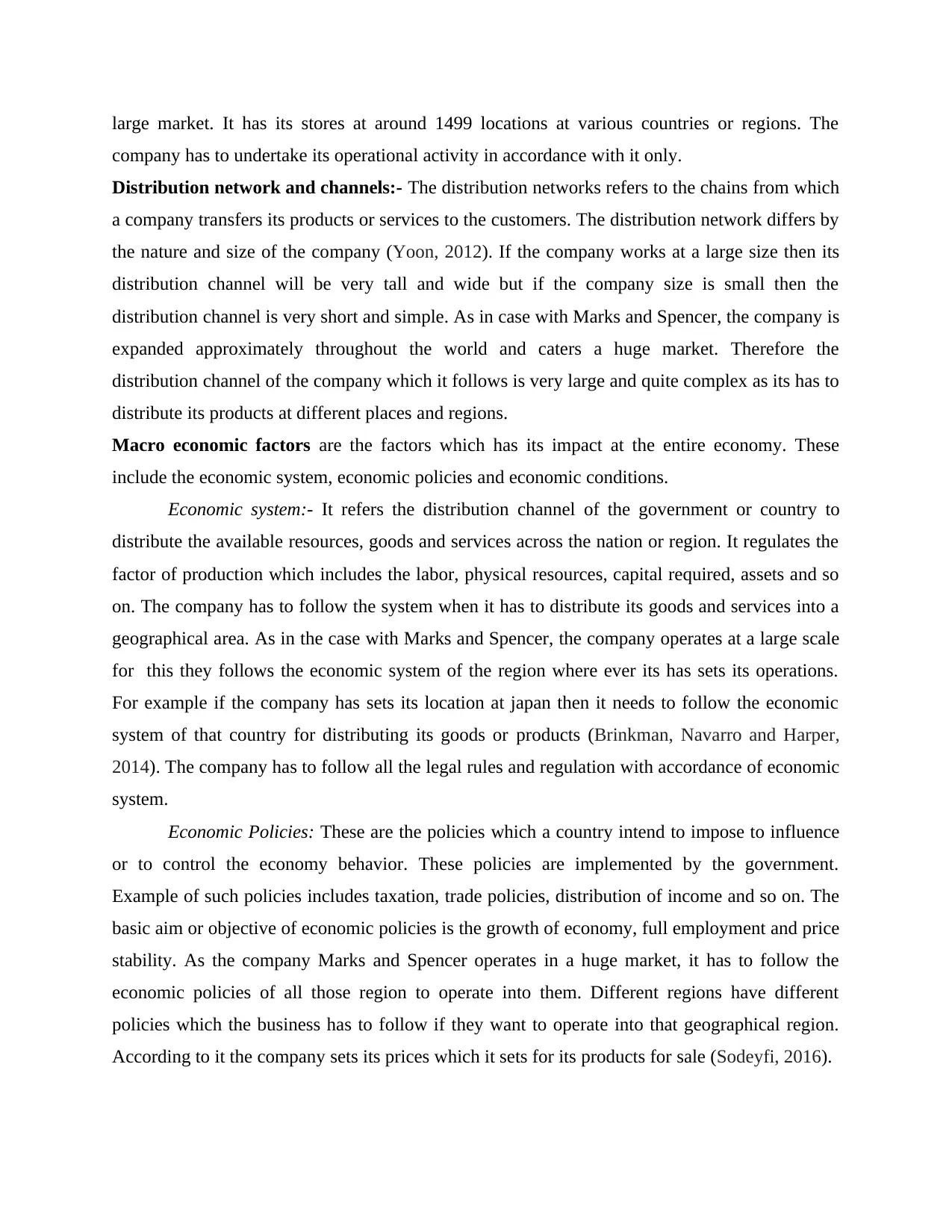
large market. It has its stores at around 1499 locations at various countries or regions. The
company has to undertake its operational activity in accordance with it only.
Distribution network and channels:- The distribution networks refers to the chains from which
a company transfers its products or services to the customers. The distribution network differs by
the nature and size of the company (Yoon, 2012). If the company works at a large size then its
distribution channel will be very tall and wide but if the company size is small then the
distribution channel is very short and simple. As in case with Marks and Spencer, the company is
expanded approximately throughout the world and caters a huge market. Therefore the
distribution channel of the company which it follows is very large and quite complex as its has to
distribute its products at different places and regions.
Macro economic factors are the factors which has its impact at the entire economy. These
include the economic system, economic policies and economic conditions.
Economic system:- It refers the distribution channel of the government or country to
distribute the available resources, goods and services across the nation or region. It regulates the
factor of production which includes the labor, physical resources, capital required, assets and so
on. The company has to follow the system when it has to distribute its goods and services into a
geographical area. As in the case with Marks and Spencer, the company operates at a large scale
for this they follows the economic system of the region where ever its has sets its operations.
For example if the company has sets its location at japan then it needs to follow the economic
system of that country for distributing its goods or products (Brinkman, Navarro and Harper,
2014). The company has to follow all the legal rules and regulation with accordance of economic
system.
Economic Policies: These are the policies which a country intend to impose to influence
or to control the economy behavior. These policies are implemented by the government.
Example of such policies includes taxation, trade policies, distribution of income and so on. The
basic aim or objective of economic policies is the growth of economy, full employment and price
stability. As the company Marks and Spencer operates in a huge market, it has to follow the
economic policies of all those region to operate into them. Different regions have different
policies which the business has to follow if they want to operate into that geographical region.
According to it the company sets its prices which it sets for its products for sale (Sodeyfi, 2016).
company has to undertake its operational activity in accordance with it only.
Distribution network and channels:- The distribution networks refers to the chains from which
a company transfers its products or services to the customers. The distribution network differs by
the nature and size of the company (Yoon, 2012). If the company works at a large size then its
distribution channel will be very tall and wide but if the company size is small then the
distribution channel is very short and simple. As in case with Marks and Spencer, the company is
expanded approximately throughout the world and caters a huge market. Therefore the
distribution channel of the company which it follows is very large and quite complex as its has to
distribute its products at different places and regions.
Macro economic factors are the factors which has its impact at the entire economy. These
include the economic system, economic policies and economic conditions.
Economic system:- It refers the distribution channel of the government or country to
distribute the available resources, goods and services across the nation or region. It regulates the
factor of production which includes the labor, physical resources, capital required, assets and so
on. The company has to follow the system when it has to distribute its goods and services into a
geographical area. As in the case with Marks and Spencer, the company operates at a large scale
for this they follows the economic system of the region where ever its has sets its operations.
For example if the company has sets its location at japan then it needs to follow the economic
system of that country for distributing its goods or products (Brinkman, Navarro and Harper,
2014). The company has to follow all the legal rules and regulation with accordance of economic
system.
Economic Policies: These are the policies which a country intend to impose to influence
or to control the economy behavior. These policies are implemented by the government.
Example of such policies includes taxation, trade policies, distribution of income and so on. The
basic aim or objective of economic policies is the growth of economy, full employment and price
stability. As the company Marks and Spencer operates in a huge market, it has to follow the
economic policies of all those region to operate into them. Different regions have different
policies which the business has to follow if they want to operate into that geographical region.
According to it the company sets its prices which it sets for its products for sale (Sodeyfi, 2016).
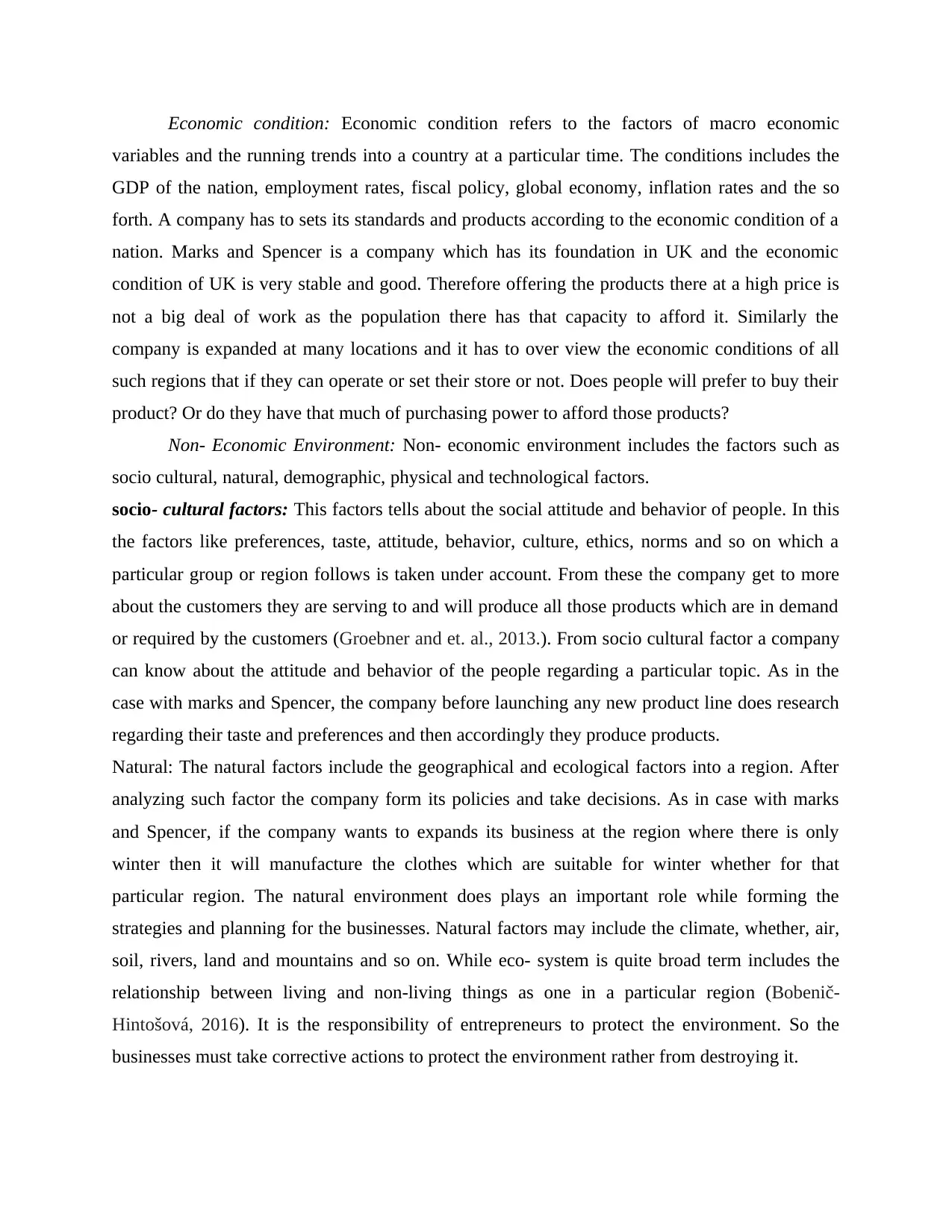
Economic condition: Economic condition refers to the factors of macro economic
variables and the running trends into a country at a particular time. The conditions includes the
GDP of the nation, employment rates, fiscal policy, global economy, inflation rates and the so
forth. A company has to sets its standards and products according to the economic condition of a
nation. Marks and Spencer is a company which has its foundation in UK and the economic
condition of UK is very stable and good. Therefore offering the products there at a high price is
not a big deal of work as the population there has that capacity to afford it. Similarly the
company is expanded at many locations and it has to over view the economic conditions of all
such regions that if they can operate or set their store or not. Does people will prefer to buy their
product? Or do they have that much of purchasing power to afford those products?
Non- Economic Environment: Non- economic environment includes the factors such as
socio cultural, natural, demographic, physical and technological factors.
socio- cultural factors: This factors tells about the social attitude and behavior of people. In this
the factors like preferences, taste, attitude, behavior, culture, ethics, norms and so on which a
particular group or region follows is taken under account. From these the company get to more
about the customers they are serving to and will produce all those products which are in demand
or required by the customers (Groebner and et. al., 2013.). From socio cultural factor a company
can know about the attitude and behavior of the people regarding a particular topic. As in the
case with marks and Spencer, the company before launching any new product line does research
regarding their taste and preferences and then accordingly they produce products.
Natural: The natural factors include the geographical and ecological factors into a region. After
analyzing such factor the company form its policies and take decisions. As in case with marks
and Spencer, if the company wants to expands its business at the region where there is only
winter then it will manufacture the clothes which are suitable for winter whether for that
particular region. The natural environment does plays an important role while forming the
strategies and planning for the businesses. Natural factors may include the climate, whether, air,
soil, rivers, land and mountains and so on. While eco- system is quite broad term includes the
relationship between living and non-living things as one in a particular region (Bobenič-
Hintošová, 2016). It is the responsibility of entrepreneurs to protect the environment. So the
businesses must take corrective actions to protect the environment rather from destroying it.
variables and the running trends into a country at a particular time. The conditions includes the
GDP of the nation, employment rates, fiscal policy, global economy, inflation rates and the so
forth. A company has to sets its standards and products according to the economic condition of a
nation. Marks and Spencer is a company which has its foundation in UK and the economic
condition of UK is very stable and good. Therefore offering the products there at a high price is
not a big deal of work as the population there has that capacity to afford it. Similarly the
company is expanded at many locations and it has to over view the economic conditions of all
such regions that if they can operate or set their store or not. Does people will prefer to buy their
product? Or do they have that much of purchasing power to afford those products?
Non- Economic Environment: Non- economic environment includes the factors such as
socio cultural, natural, demographic, physical and technological factors.
socio- cultural factors: This factors tells about the social attitude and behavior of people. In this
the factors like preferences, taste, attitude, behavior, culture, ethics, norms and so on which a
particular group or region follows is taken under account. From these the company get to more
about the customers they are serving to and will produce all those products which are in demand
or required by the customers (Groebner and et. al., 2013.). From socio cultural factor a company
can know about the attitude and behavior of the people regarding a particular topic. As in the
case with marks and Spencer, the company before launching any new product line does research
regarding their taste and preferences and then accordingly they produce products.
Natural: The natural factors include the geographical and ecological factors into a region. After
analyzing such factor the company form its policies and take decisions. As in case with marks
and Spencer, if the company wants to expands its business at the region where there is only
winter then it will manufacture the clothes which are suitable for winter whether for that
particular region. The natural environment does plays an important role while forming the
strategies and planning for the businesses. Natural factors may include the climate, whether, air,
soil, rivers, land and mountains and so on. While eco- system is quite broad term includes the
relationship between living and non-living things as one in a particular region (Bobenič-
Hintošová, 2016). It is the responsibility of entrepreneurs to protect the environment. So the
businesses must take corrective actions to protect the environment rather from destroying it.
⊘ This is a preview!⊘
Do you want full access?
Subscribe today to unlock all pages.

Trusted by 1+ million students worldwide
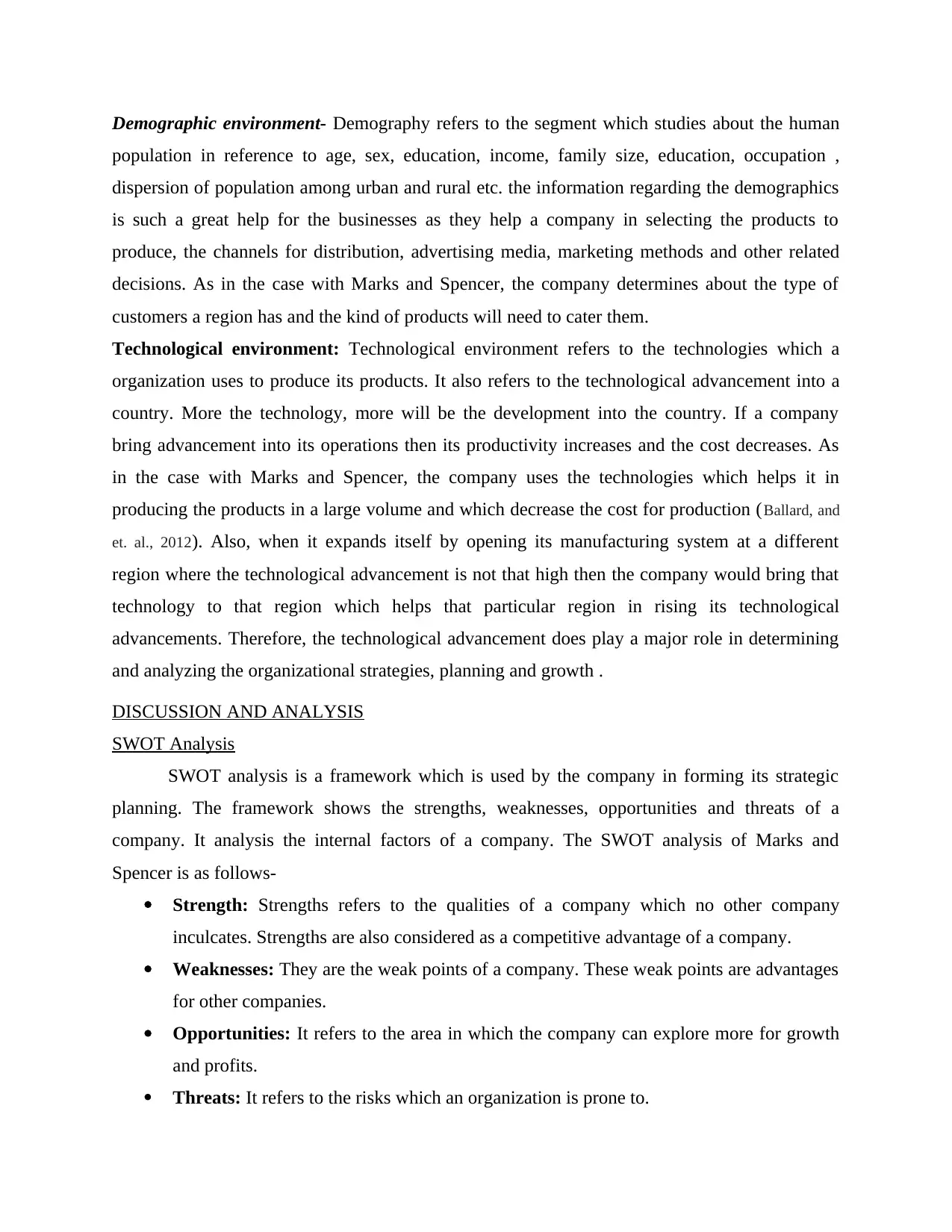
Demographic environment- Demography refers to the segment which studies about the human
population in reference to age, sex, education, income, family size, education, occupation ,
dispersion of population among urban and rural etc. the information regarding the demographics
is such a great help for the businesses as they help a company in selecting the products to
produce, the channels for distribution, advertising media, marketing methods and other related
decisions. As in the case with Marks and Spencer, the company determines about the type of
customers a region has and the kind of products will need to cater them.
Technological environment: Technological environment refers to the technologies which a
organization uses to produce its products. It also refers to the technological advancement into a
country. More the technology, more will be the development into the country. If a company
bring advancement into its operations then its productivity increases and the cost decreases. As
in the case with Marks and Spencer, the company uses the technologies which helps it in
producing the products in a large volume and which decrease the cost for production (Ballard, and
et. al., 2012). Also, when it expands itself by opening its manufacturing system at a different
region where the technological advancement is not that high then the company would bring that
technology to that region which helps that particular region in rising its technological
advancements. Therefore, the technological advancement does play a major role in determining
and analyzing the organizational strategies, planning and growth .
DISCUSSION AND ANALYSIS
SWOT Analysis
SWOT analysis is a framework which is used by the company in forming its strategic
planning. The framework shows the strengths, weaknesses, opportunities and threats of a
company. It analysis the internal factors of a company. The SWOT analysis of Marks and
Spencer is as follows-
Strength: Strengths refers to the qualities of a company which no other company
inculcates. Strengths are also considered as a competitive advantage of a company.
Weaknesses: They are the weak points of a company. These weak points are advantages
for other companies.
Opportunities: It refers to the area in which the company can explore more for growth
and profits.
Threats: It refers to the risks which an organization is prone to.
population in reference to age, sex, education, income, family size, education, occupation ,
dispersion of population among urban and rural etc. the information regarding the demographics
is such a great help for the businesses as they help a company in selecting the products to
produce, the channels for distribution, advertising media, marketing methods and other related
decisions. As in the case with Marks and Spencer, the company determines about the type of
customers a region has and the kind of products will need to cater them.
Technological environment: Technological environment refers to the technologies which a
organization uses to produce its products. It also refers to the technological advancement into a
country. More the technology, more will be the development into the country. If a company
bring advancement into its operations then its productivity increases and the cost decreases. As
in the case with Marks and Spencer, the company uses the technologies which helps it in
producing the products in a large volume and which decrease the cost for production (Ballard, and
et. al., 2012). Also, when it expands itself by opening its manufacturing system at a different
region where the technological advancement is not that high then the company would bring that
technology to that region which helps that particular region in rising its technological
advancements. Therefore, the technological advancement does play a major role in determining
and analyzing the organizational strategies, planning and growth .
DISCUSSION AND ANALYSIS
SWOT Analysis
SWOT analysis is a framework which is used by the company in forming its strategic
planning. The framework shows the strengths, weaknesses, opportunities and threats of a
company. It analysis the internal factors of a company. The SWOT analysis of Marks and
Spencer is as follows-
Strength: Strengths refers to the qualities of a company which no other company
inculcates. Strengths are also considered as a competitive advantage of a company.
Weaknesses: They are the weak points of a company. These weak points are advantages
for other companies.
Opportunities: It refers to the area in which the company can explore more for growth
and profits.
Threats: It refers to the risks which an organization is prone to.
Paraphrase This Document
Need a fresh take? Get an instant paraphrase of this document with our AI Paraphraser
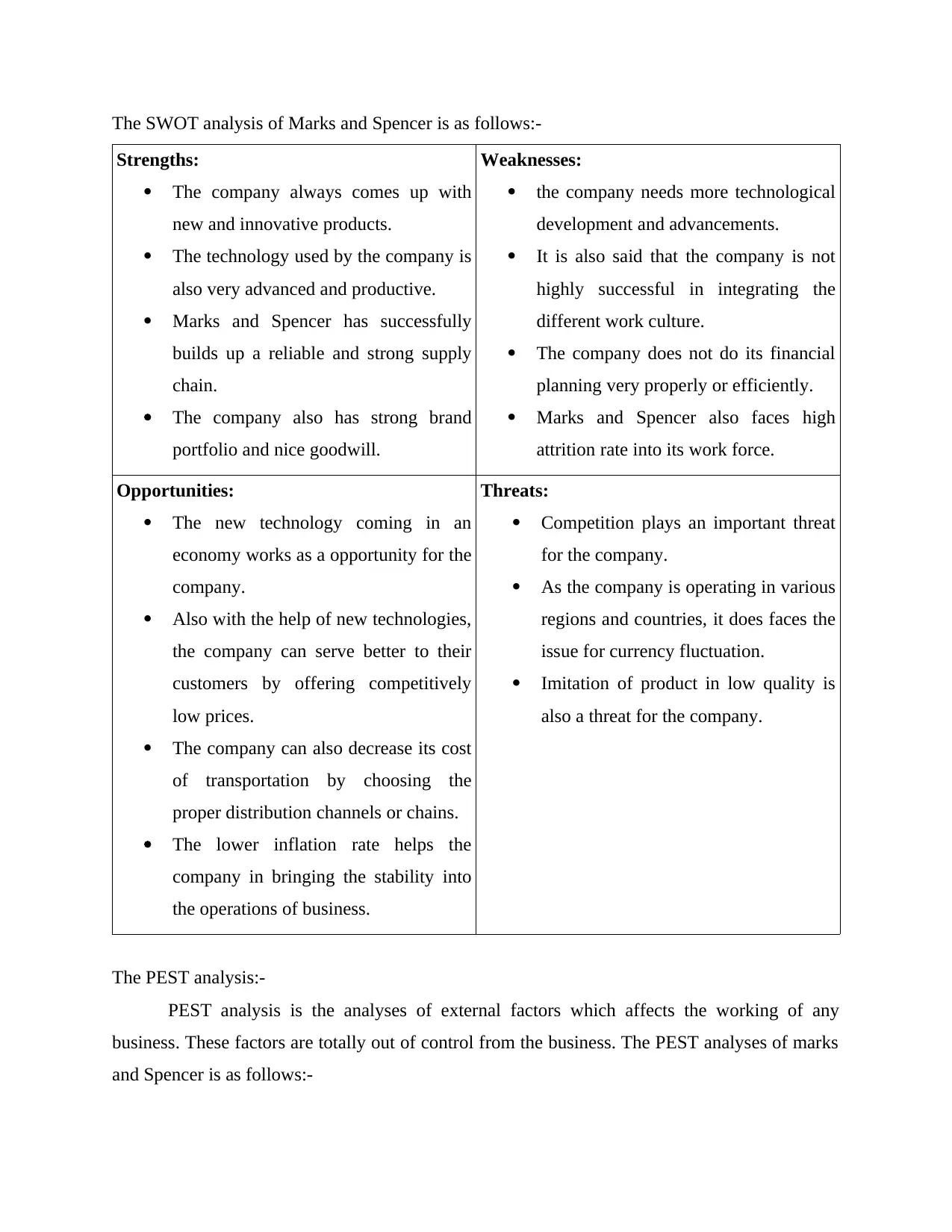
The SWOT analysis of Marks and Spencer is as follows:-
Strengths:
The company always comes up with
new and innovative products.
The technology used by the company is
also very advanced and productive.
Marks and Spencer has successfully
builds up a reliable and strong supply
chain.
The company also has strong brand
portfolio and nice goodwill.
Weaknesses:
the company needs more technological
development and advancements.
It is also said that the company is not
highly successful in integrating the
different work culture.
The company does not do its financial
planning very properly or efficiently.
Marks and Spencer also faces high
attrition rate into its work force.
Opportunities:
The new technology coming in an
economy works as a opportunity for the
company.
Also with the help of new technologies,
the company can serve better to their
customers by offering competitively
low prices.
The company can also decrease its cost
of transportation by choosing the
proper distribution channels or chains.
The lower inflation rate helps the
company in bringing the stability into
the operations of business.
Threats:
Competition plays an important threat
for the company.
As the company is operating in various
regions and countries, it does faces the
issue for currency fluctuation.
Imitation of product in low quality is
also a threat for the company.
The PEST analysis:-
PEST analysis is the analyses of external factors which affects the working of any
business. These factors are totally out of control from the business. The PEST analyses of marks
and Spencer is as follows:-
Strengths:
The company always comes up with
new and innovative products.
The technology used by the company is
also very advanced and productive.
Marks and Spencer has successfully
builds up a reliable and strong supply
chain.
The company also has strong brand
portfolio and nice goodwill.
Weaknesses:
the company needs more technological
development and advancements.
It is also said that the company is not
highly successful in integrating the
different work culture.
The company does not do its financial
planning very properly or efficiently.
Marks and Spencer also faces high
attrition rate into its work force.
Opportunities:
The new technology coming in an
economy works as a opportunity for the
company.
Also with the help of new technologies,
the company can serve better to their
customers by offering competitively
low prices.
The company can also decrease its cost
of transportation by choosing the
proper distribution channels or chains.
The lower inflation rate helps the
company in bringing the stability into
the operations of business.
Threats:
Competition plays an important threat
for the company.
As the company is operating in various
regions and countries, it does faces the
issue for currency fluctuation.
Imitation of product in low quality is
also a threat for the company.
The PEST analysis:-
PEST analysis is the analyses of external factors which affects the working of any
business. These factors are totally out of control from the business. The PEST analyses of marks
and Spencer is as follows:-
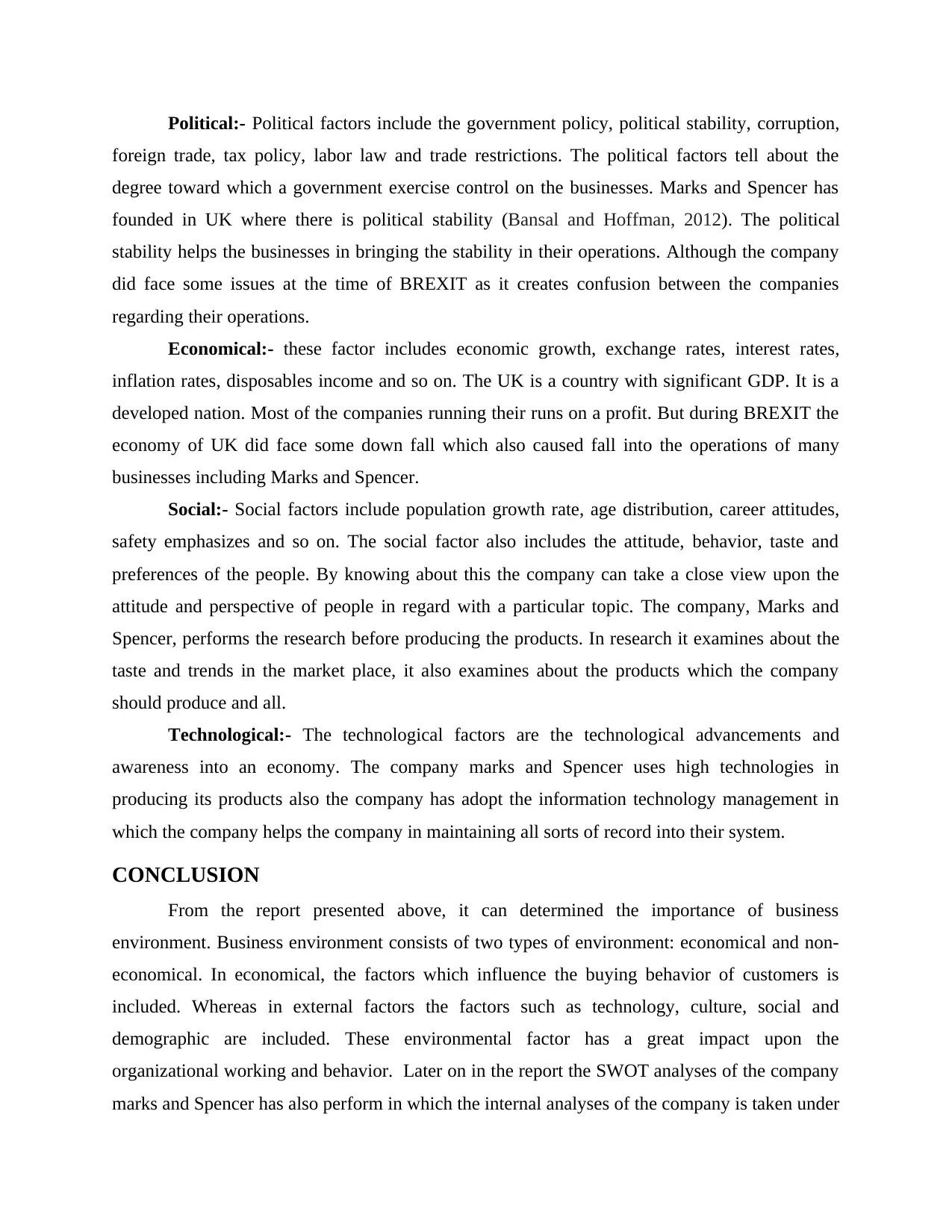
Political:- Political factors include the government policy, political stability, corruption,
foreign trade, tax policy, labor law and trade restrictions. The political factors tell about the
degree toward which a government exercise control on the businesses. Marks and Spencer has
founded in UK where there is political stability (Bansal and Hoffman, 2012). The political
stability helps the businesses in bringing the stability in their operations. Although the company
did face some issues at the time of BREXIT as it creates confusion between the companies
regarding their operations.
Economical:- these factor includes economic growth, exchange rates, interest rates,
inflation rates, disposables income and so on. The UK is a country with significant GDP. It is a
developed nation. Most of the companies running their runs on a profit. But during BREXIT the
economy of UK did face some down fall which also caused fall into the operations of many
businesses including Marks and Spencer.
Social:- Social factors include population growth rate, age distribution, career attitudes,
safety emphasizes and so on. The social factor also includes the attitude, behavior, taste and
preferences of the people. By knowing about this the company can take a close view upon the
attitude and perspective of people in regard with a particular topic. The company, Marks and
Spencer, performs the research before producing the products. In research it examines about the
taste and trends in the market place, it also examines about the products which the company
should produce and all.
Technological:- The technological factors are the technological advancements and
awareness into an economy. The company marks and Spencer uses high technologies in
producing its products also the company has adopt the information technology management in
which the company helps the company in maintaining all sorts of record into their system.
CONCLUSION
From the report presented above, it can determined the importance of business
environment. Business environment consists of two types of environment: economical and non-
economical. In economical, the factors which influence the buying behavior of customers is
included. Whereas in external factors the factors such as technology, culture, social and
demographic are included. These environmental factor has a great impact upon the
organizational working and behavior. Later on in the report the SWOT analyses of the company
marks and Spencer has also perform in which the internal analyses of the company is taken under
foreign trade, tax policy, labor law and trade restrictions. The political factors tell about the
degree toward which a government exercise control on the businesses. Marks and Spencer has
founded in UK where there is political stability (Bansal and Hoffman, 2012). The political
stability helps the businesses in bringing the stability in their operations. Although the company
did face some issues at the time of BREXIT as it creates confusion between the companies
regarding their operations.
Economical:- these factor includes economic growth, exchange rates, interest rates,
inflation rates, disposables income and so on. The UK is a country with significant GDP. It is a
developed nation. Most of the companies running their runs on a profit. But during BREXIT the
economy of UK did face some down fall which also caused fall into the operations of many
businesses including Marks and Spencer.
Social:- Social factors include population growth rate, age distribution, career attitudes,
safety emphasizes and so on. The social factor also includes the attitude, behavior, taste and
preferences of the people. By knowing about this the company can take a close view upon the
attitude and perspective of people in regard with a particular topic. The company, Marks and
Spencer, performs the research before producing the products. In research it examines about the
taste and trends in the market place, it also examines about the products which the company
should produce and all.
Technological:- The technological factors are the technological advancements and
awareness into an economy. The company marks and Spencer uses high technologies in
producing its products also the company has adopt the information technology management in
which the company helps the company in maintaining all sorts of record into their system.
CONCLUSION
From the report presented above, it can determined the importance of business
environment. Business environment consists of two types of environment: economical and non-
economical. In economical, the factors which influence the buying behavior of customers is
included. Whereas in external factors the factors such as technology, culture, social and
demographic are included. These environmental factor has a great impact upon the
organizational working and behavior. Later on in the report the SWOT analyses of the company
marks and Spencer has also perform in which the internal analyses of the company is taken under
⊘ This is a preview!⊘
Do you want full access?
Subscribe today to unlock all pages.

Trusted by 1+ million students worldwide
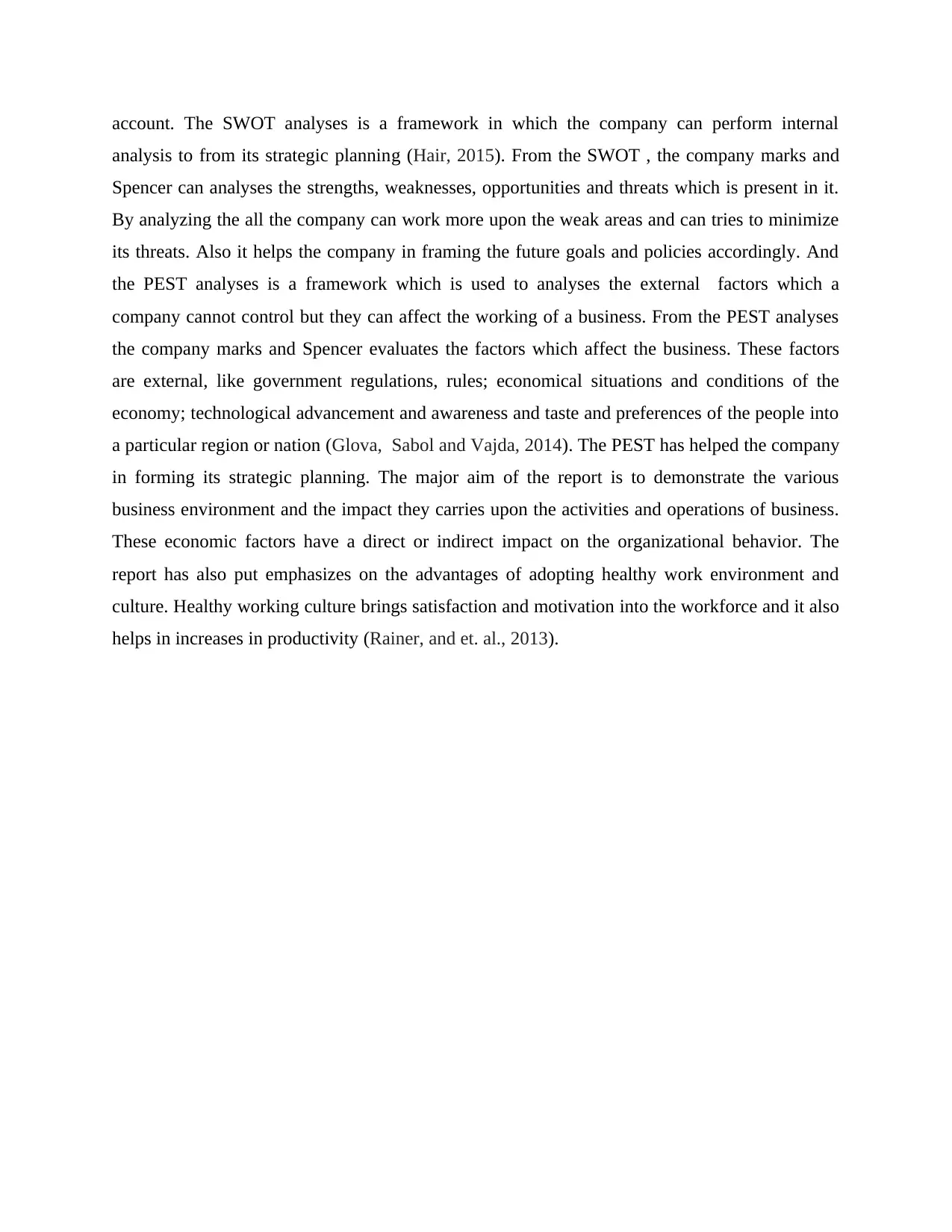
account. The SWOT analyses is a framework in which the company can perform internal
analysis to from its strategic planning (Hair, 2015). From the SWOT , the company marks and
Spencer can analyses the strengths, weaknesses, opportunities and threats which is present in it.
By analyzing the all the company can work more upon the weak areas and can tries to minimize
its threats. Also it helps the company in framing the future goals and policies accordingly. And
the PEST analyses is a framework which is used to analyses the external factors which a
company cannot control but they can affect the working of a business. From the PEST analyses
the company marks and Spencer evaluates the factors which affect the business. These factors
are external, like government regulations, rules; economical situations and conditions of the
economy; technological advancement and awareness and taste and preferences of the people into
a particular region or nation (Glova, Sabol and Vajda, 2014). The PEST has helped the company
in forming its strategic planning. The major aim of the report is to demonstrate the various
business environment and the impact they carries upon the activities and operations of business.
These economic factors have a direct or indirect impact on the organizational behavior. The
report has also put emphasizes on the advantages of adopting healthy work environment and
culture. Healthy working culture brings satisfaction and motivation into the workforce and it also
helps in increases in productivity (Rainer, and et. al., 2013).
analysis to from its strategic planning (Hair, 2015). From the SWOT , the company marks and
Spencer can analyses the strengths, weaknesses, opportunities and threats which is present in it.
By analyzing the all the company can work more upon the weak areas and can tries to minimize
its threats. Also it helps the company in framing the future goals and policies accordingly. And
the PEST analyses is a framework which is used to analyses the external factors which a
company cannot control but they can affect the working of a business. From the PEST analyses
the company marks and Spencer evaluates the factors which affect the business. These factors
are external, like government regulations, rules; economical situations and conditions of the
economy; technological advancement and awareness and taste and preferences of the people into
a particular region or nation (Glova, Sabol and Vajda, 2014). The PEST has helped the company
in forming its strategic planning. The major aim of the report is to demonstrate the various
business environment and the impact they carries upon the activities and operations of business.
These economic factors have a direct or indirect impact on the organizational behavior. The
report has also put emphasizes on the advantages of adopting healthy work environment and
culture. Healthy working culture brings satisfaction and motivation into the workforce and it also
helps in increases in productivity (Rainer, and et. al., 2013).
Paraphrase This Document
Need a fresh take? Get an instant paraphrase of this document with our AI Paraphraser
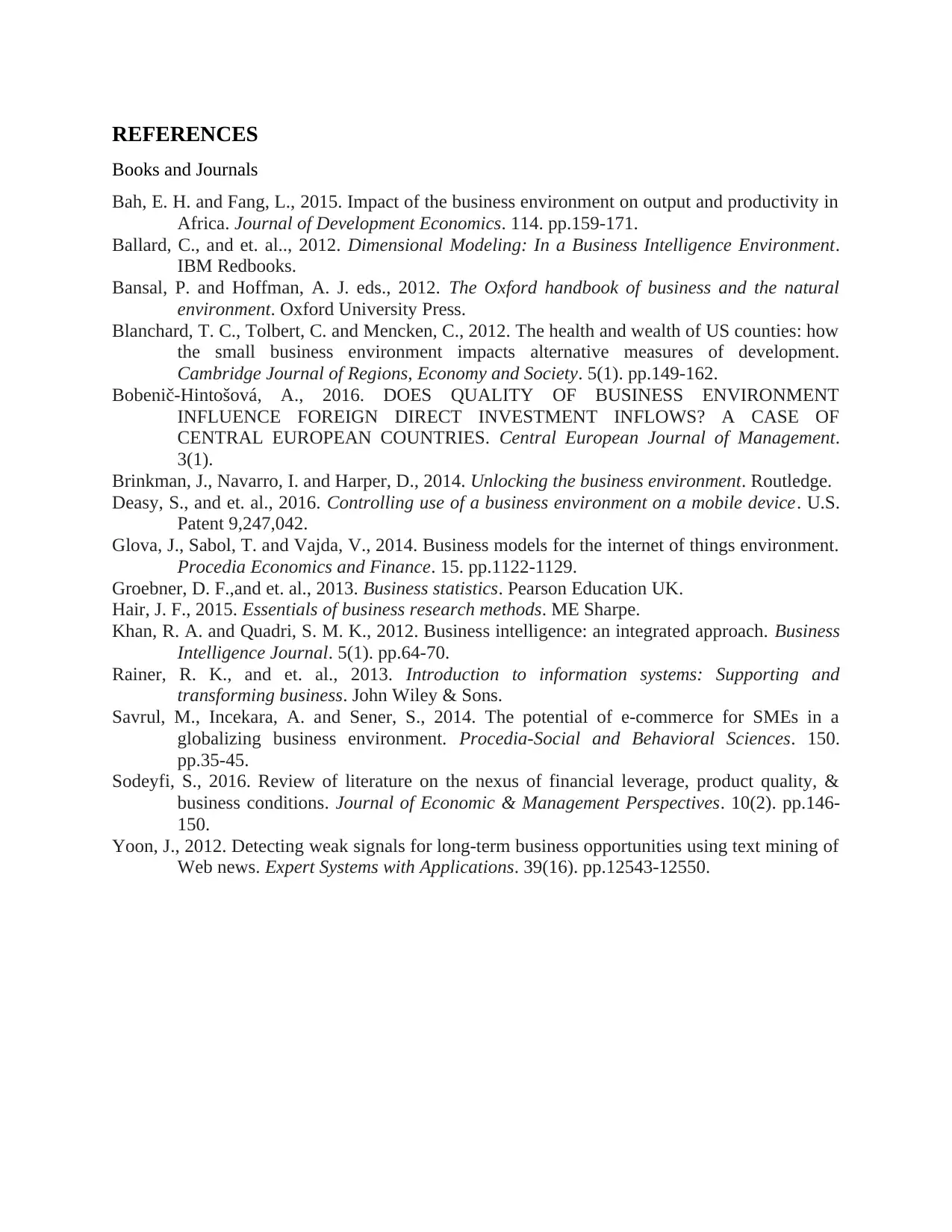
REFERENCES
Books and Journals
Bah, E. H. and Fang, L., 2015. Impact of the business environment on output and productivity in
Africa. Journal of Development Economics. 114. pp.159-171.
Ballard, C., and et. al.., 2012. Dimensional Modeling: In a Business Intelligence Environment.
IBM Redbooks.
Bansal, P. and Hoffman, A. J. eds., 2012. The Oxford handbook of business and the natural
environment. Oxford University Press.
Blanchard, T. C., Tolbert, C. and Mencken, C., 2012. The health and wealth of US counties: how
the small business environment impacts alternative measures of development.
Cambridge Journal of Regions, Economy and Society. 5(1). pp.149-162.
Bobenič-Hintošová, A., 2016. DOES QUALITY OF BUSINESS ENVIRONMENT
INFLUENCE FOREIGN DIRECT INVESTMENT INFLOWS? A CASE OF
CENTRAL EUROPEAN COUNTRIES. Central European Journal of Management.
3(1).
Brinkman, J., Navarro, I. and Harper, D., 2014. Unlocking the business environment. Routledge.
Deasy, S., and et. al., 2016. Controlling use of a business environment on a mobile device. U.S.
Patent 9,247,042.
Glova, J., Sabol, T. and Vajda, V., 2014. Business models for the internet of things environment.
Procedia Economics and Finance. 15. pp.1122-1129.
Groebner, D. F.,and et. al., 2013. Business statistics. Pearson Education UK.
Hair, J. F., 2015. Essentials of business research methods. ME Sharpe.
Khan, R. A. and Quadri, S. M. K., 2012. Business intelligence: an integrated approach. Business
Intelligence Journal. 5(1). pp.64-70.
Rainer, R. K., and et. al., 2013. Introduction to information systems: Supporting and
transforming business. John Wiley & Sons.
Savrul, M., Incekara, A. and Sener, S., 2014. The potential of e-commerce for SMEs in a
globalizing business environment. Procedia-Social and Behavioral Sciences. 150.
pp.35-45.
Sodeyfi, S., 2016. Review of literature on the nexus of financial leverage, product quality, &
business conditions. Journal of Economic & Management Perspectives. 10(2). pp.146-
150.
Yoon, J., 2012. Detecting weak signals for long-term business opportunities using text mining of
Web news. Expert Systems with Applications. 39(16). pp.12543-12550.
Books and Journals
Bah, E. H. and Fang, L., 2015. Impact of the business environment on output and productivity in
Africa. Journal of Development Economics. 114. pp.159-171.
Ballard, C., and et. al.., 2012. Dimensional Modeling: In a Business Intelligence Environment.
IBM Redbooks.
Bansal, P. and Hoffman, A. J. eds., 2012. The Oxford handbook of business and the natural
environment. Oxford University Press.
Blanchard, T. C., Tolbert, C. and Mencken, C., 2012. The health and wealth of US counties: how
the small business environment impacts alternative measures of development.
Cambridge Journal of Regions, Economy and Society. 5(1). pp.149-162.
Bobenič-Hintošová, A., 2016. DOES QUALITY OF BUSINESS ENVIRONMENT
INFLUENCE FOREIGN DIRECT INVESTMENT INFLOWS? A CASE OF
CENTRAL EUROPEAN COUNTRIES. Central European Journal of Management.
3(1).
Brinkman, J., Navarro, I. and Harper, D., 2014. Unlocking the business environment. Routledge.
Deasy, S., and et. al., 2016. Controlling use of a business environment on a mobile device. U.S.
Patent 9,247,042.
Glova, J., Sabol, T. and Vajda, V., 2014. Business models for the internet of things environment.
Procedia Economics and Finance. 15. pp.1122-1129.
Groebner, D. F.,and et. al., 2013. Business statistics. Pearson Education UK.
Hair, J. F., 2015. Essentials of business research methods. ME Sharpe.
Khan, R. A. and Quadri, S. M. K., 2012. Business intelligence: an integrated approach. Business
Intelligence Journal. 5(1). pp.64-70.
Rainer, R. K., and et. al., 2013. Introduction to information systems: Supporting and
transforming business. John Wiley & Sons.
Savrul, M., Incekara, A. and Sener, S., 2014. The potential of e-commerce for SMEs in a
globalizing business environment. Procedia-Social and Behavioral Sciences. 150.
pp.35-45.
Sodeyfi, S., 2016. Review of literature on the nexus of financial leverage, product quality, &
business conditions. Journal of Economic & Management Perspectives. 10(2). pp.146-
150.
Yoon, J., 2012. Detecting weak signals for long-term business opportunities using text mining of
Web news. Expert Systems with Applications. 39(16). pp.12543-12550.
1 out of 11
Related Documents
Your All-in-One AI-Powered Toolkit for Academic Success.
+13062052269
info@desklib.com
Available 24*7 on WhatsApp / Email
![[object Object]](/_next/static/media/star-bottom.7253800d.svg)
Unlock your academic potential
Copyright © 2020–2025 A2Z Services. All Rights Reserved. Developed and managed by ZUCOL.




